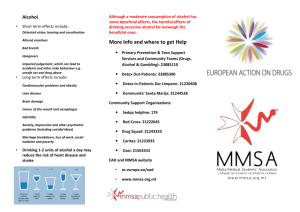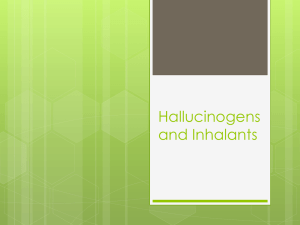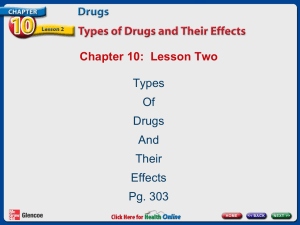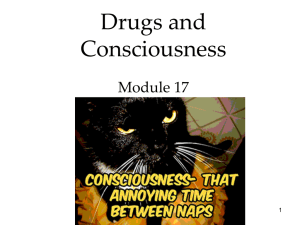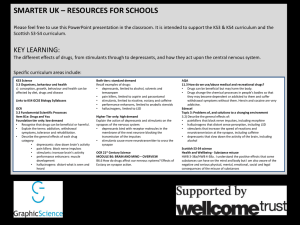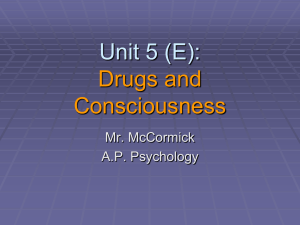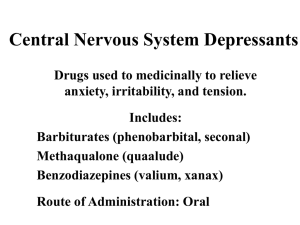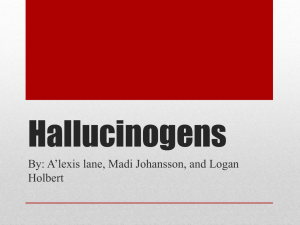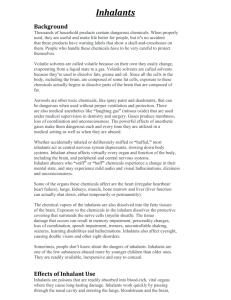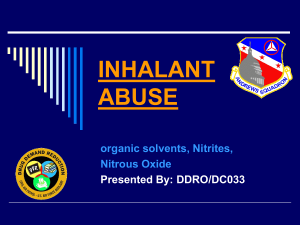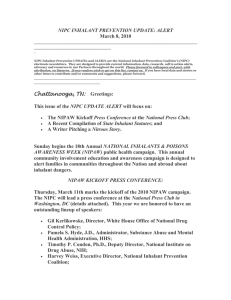The Effects of Drugs - Julia`s General Education Portfolio
advertisement
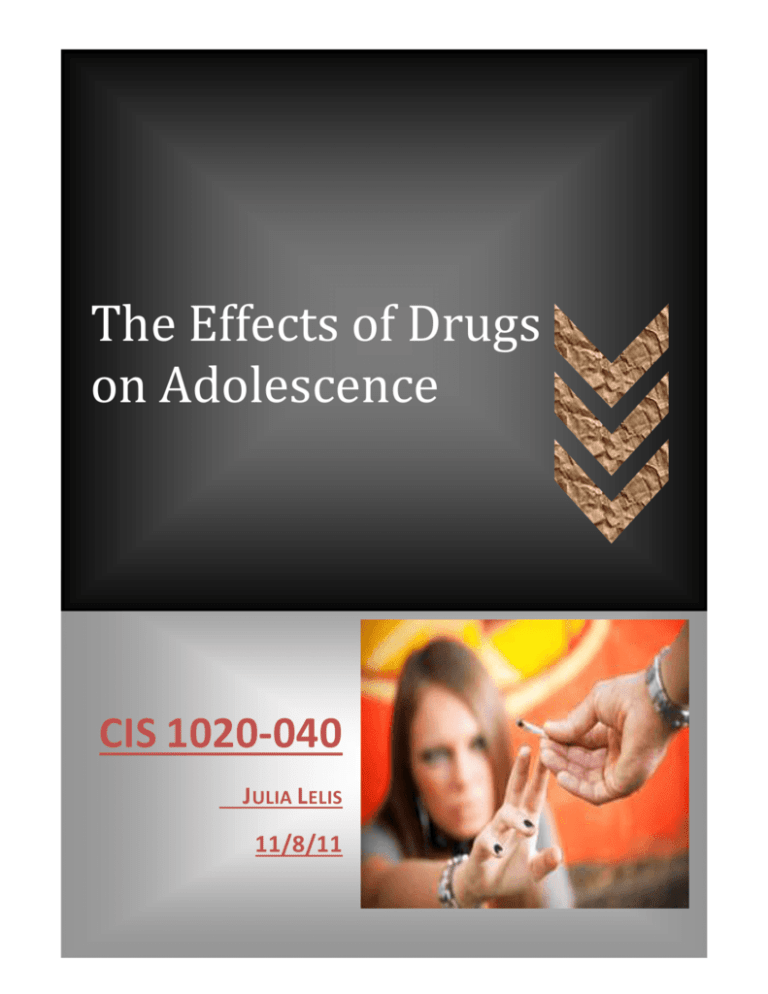
The Effects of Drugs on Adolescence CIS 1020-040 JULIA LELIS 11/8/11 Table of Contents Table of Contents .......................................................................................................................................... ii Table of Figures ............................................................................................................................................ iii Adolescent Drug Exposure ............................................................................................................................ ii Stimulants .................................................................................................................................................... iv Symptoms of Excessive Stimulant Drugs ...................................................................................................... v Depressants.................................................................................................................................................. vi Symptoms of Excessive Depressant Drugs.................................................................................................. vii Hallucinogens ............................................................................................................................................. viii Symptoms of Excessive Hallucinogen Drugs ................................................................................................ ix Inhalants........................................................................................................................................................ x Symptoms of Excessive Inhalant Drugs....................................................................................................... xii As you can see… ..........................................................................................................................................xiii Works Cited .................................................................................................................................................xiv The Effects of Drugs ii Page | ii Table of Figures Figure 1, Stimulant Drugs................................................................................................................................ Figure 2, Depressant Drugs ............................................................................................................................. Figure 3, Depressant Drugs ............................................................................................................................. Page | iii Figure 4, Hallucinogen Drugs ..................................................................................................................... viii Figure 5, Drug Depressant Use .................................................................................................................... ix Figure 6, Inhalant Drugs ................................................................................................................................ x Figure 7, Inhalant Drug Use ........................................................................................................................ xii iii Adolescent Drug Exposure Teens all over the world are unfortunately exposed to drugs more frequently than generations before them had ever anticipated. The pressure of taking and doing drugs that the youth endures today is immense and ludicrous. The media portrays drinking and smoking weed as a norm for the everyweekend teenage party goer. I have heard countless numbers of songs, generally in the Rap or Hip-Hop genre pertaining to drug abuse in all its glory. From Marijuana to Heroin, addictions can be formed quickly and early on in an adolescent life, and the idea of using drugs is a consistent battle amongst today’s youth. Most teens don’t expect to develop a drug addiction when they try drugs, but usually, with the use and abuse of drugs in order to “have fun,” addictions form, and the consequences are sometimes fatal. Teens as young as 13 have often already tried drugs as powerful as cocaine (Teen Drug Abuse, 2011). Most Frequently Prominent Signs of Addiction Grades suddenly slipping or dropping dramatically. Missing school Mood changes Dropping out of usually activities Physical appearance changing Adolescent Drug Abuse Friends suddenly change Money or valuables missing Secretive behavior Hostile, aggressive outbursts Lost motivation Forgetfulness Unusual sleeping habits Depressed Anxious Table 1, Signs of Adolescent Drug Abuse Page | ii From this table, we can conclude that most signs of addiction usually correspond with the given information. Skipping school frequently is definitely a red flag that trouble is going on behind the scenes. If a child is often too "tired" or "sick" to go to school, this could be a warning as well. Drug abusing teens are often irritable or emotional, and along with their emotions dropping, their hygiene usually turns to poor. They will drop out of normal activities, such as music, sports, or other hobbies, friends suddenly change, and new friends will often not be introduced. Their style of clothing changes as often as their friends do, and their emotional rollercoaster will often send them through anxiety, depression, hostile and aggressive outbursts, and loss of motivation. Their sleeping habits often turn to little or no sleep, or excessively long periods of sleep to the point where they will sleep literally all day. They become forgetful, and secretive. For example, their bedroom door may frequently be locked, or they could possibly spend large amounts of time in the bathroom. Money and other valuables will go missing from their room, or even from their parents’ wallets or other hiding places (Adolescent Substance Abuse Knowledge Base, 2007). Teenage drug abuse affects not only adolescents but also their families, friends and sometimes total strangers. Teenagers who drive while impaired risk causing a car crash and harming themselves and others. Girls who abuse alcohol and drugs are more likely to have unprotected sex, contract sexually transmitted diseases and have unplanned pregnancies. Adolescents who abuse drugs are more likely to be depressed and engage in violent behavior. Adolescents are also at risk for using drugs to attempt suicide (Adamec, 2010). There is no way of knowing exactly how many types of drugs there are, but we do know that there are countless numbers of both legal and illegal drugs. The different categories of drugs include: Stimulants, Depressants, Hallucinogens, Inhalants, and so on. Alcohol is also considered a depressant drug, and is probably the most popular drug throughout all classifications of drugs. Page | iii Stimulants Stimulants are a class of psychoactive drug that increase activity in the brain. These drugs can temporarily elevate alertness, mood and awareness. While some stimulant drugs are legal and widely used, all can be addicting. While stimulants share many commonalities, each has unique properties and mechanisms of action. Stimulants can be taken orally in pill form, inhaled nasally, smoked, or injected (Cherry). PRESCRIPTION DRUGS NICOTINE CAFFEINE STIMULANTS COCAINE METH Figure 1, Stimulant Drugs Chronic, long term use may cause increased aggressiveness, panic attacks, seizures bronchitis, nausea, vomiting, cancer of the throat and/or lungs, long periods without sleeping or eating, increased heart rate, chest pain, cardio vascular diseases, toxic delirium, tremors, terminal seizures, psychotic features, hallucinations, hypertension, irregular breathing, Dermatosis, Stroke, or death (Youth on Drugs). Page | iv What are the possible effects of stimulant use? Agitation, excessive activity, talkativeness, overconfidence, euphoria Irritability, argumentativeness or nervousness Enhanced concentration, suppressed tiredness A feeling of restlessness, anxiety Drug Stimulant Use Headache Excessive perspiration Increased blood pressure and/or respiratory rates, reduced body temperature Heart palpitations, rapid or irregular heartbeat Dilated pupils, irritation of eyes and nose, blurred vision, delusions Decreased appetite, weight loss, nausea Coughing Cramps, diarrhea Loss of coordination, tremors in the hands, dizziness, collapse Table 2, Drug Stimulant Use Symptoms of Excessive Stimulant Drugs OVERDOSE: Agitation, increase in body temperature, hallucinations, convulsions, possible death. WITHDRAWAL: Feelings of helplessness, guilt, anxiety, depression, exhaustion, drowsiness. Symptoms of withdrawal can last 1-2 Days (Youth on Drugs) Page | v Depressants Depressants are drugs that inhibit the function of the central nervous system and are among the most widely used drugs in the world. These drugs operate by affecting neurons in the central nervous system, which leads to symptoms such as drowsiness, relaxation, decreased inhibition, anesthesia, sleep, coma and even death. All depressants also have the potential to be addictive. They can be taken orally, injected, or smoked. While central nervous system depressants all share an ability to reduce activity in the central nervous system and lower levels of awareness in the brain, there are important differences among substances within this drug class. Some are safer than others, while some depressants have more potential for use for medicinal purposes (Cherry). Chronic, long term use of depressants may cause physical dependence, loss of coordination in motor skills, slurred speech, impaired judgment, hallucinations, paranoia, impaired memory, psychotic episodes, altered eyesight, chronic fatigue, decreased libido, irregular menstrual cycle, respiratory depression, and convulsions (Youth on Drugs). ALCOHOL BARBITURATES DEPRESSANTS Benzodiazepines Inhalants& Solvants Marijuana Figure 2, Depressant Drugs Page | vi What are the possible effects of depressant use? Calm, relaxation Lack of facial expression or animation. Skin may feel cold and clammy Altered senses, reduced anxiety, Behavior similar to alcohol intoxication Staggering, stumbling, lack of coordination, slurred speech Falling asleep (nodding), difficulty concentrating Dilated pupils Decreases body temperature and heart rate Nausea, Increased perspiration Depressants taken in combination with each other or with Page | vii Drug Depressant Use alcohol have the potential to cause serious impairment or death. Table 3, Drug Depressant Use Symptoms of Excessive Depressant Drugs OVERDOSE: There are several different symptoms from the abuse and overdose of depressant drugs. Shallow respiration (breathing), clammy skin, dilated pupils, weak and rapid pulse, coma, and even possible death are the most common (Youth on Drugs). WITHDRAWAL: The withdrawal from depressants may be hazardous and/or potentially lethal. To stop abruptly or reduce the dosage of depressants the user may be at risk of convulsions, delirium, and possible death. Symptoms of withdrawal can last 810 days (Youth on Drugs). Hallucinogens Hallucinogens are drugs that cause people to experience hallucinations and alter their perception of reality. Under the influence of hallucinogens, people see images, hear sounds, and feel sensations that seem real but are not. Hallucinogens alter the way the nerve cells (neurons) work in your brain. They cause the neurons to release a neurotransmitter called serotonin. This can over activate the serotonin receptors which may affect mood, sleeping patterns and heart rate. The actions of other neurotransmitters can also be disrupted when using hallucinogens. Many hallucinogens are chemically produced. Some hallucinogens occur naturally and can be found in plants such as the Peyote Cactus or in fungi, or “magic mushrooms.” Hallucinogens can be taken orally, injected, smoked, or sniffed (Youth on Drugs). Chronic, long term use may cause extreme changes in behavior and mood, depression, violent behavior, person may sit in a trance-like state, anxiety, fearfulness, trembling hands, chills, irregular breathing, sweating, distorted senses of light, hearing, touch, smell, and perception of time, increase in blood pressure, heart rate and blood sugar, numbness of extremities and loss of muscular coordination . PCP HALLUCINOGENS ECSTACY MAGIC MUSHROOMS LSD (Acid) Figure 4, Hallucinogen Drugs Page | viii What are the possible effects of hallucinogen use? Rapidly changing feelings (immediately and long after use) Hallucinations Dizziness, confusion, nausea & vomiting Suspicion Anxiety Muscle relaxation, weakness, tremors Drug Hallucinogen Use Ataxia. or loss of the ability to coordinate muscular movement Loss of control, bad trips Dilated pupils Dry mouth Increased body temperature Increased heart rate and blood pressure Increased sweating, flushing Loss of appetite Sleeplessness, drowsiness One use of hallucinogens may cause multiple and dramatic behavioral changes and/or irreversible brain damage Figure 5, Drug Depressant Use Symptoms of Excessive Hallucinogen Drugs OVERDOSE: Longer, more intense trip, Psychosis, muscle spasms and seizures, loss of coordination, convulsions, nausea, vomiting, diarrhea, person may sit in a trance-like state, heart/lung failure, ruptured blood vessels in the brain, coma, and possible death. WITHDRAWAL: hallucinogens. There are actually no discernible withdrawal symptoms from the use of Page | ix Inhalants Inhalants are volatile (vaporize at room temperature) substances that produce chemical vapors. These vapors can be intentionally inhaled (huffing) to induce a psychoactive, or mind-altering effect similar to alcohol use. Inhalants are found in common everyday household products that we use: Air freshener, Butane, Cooking spray, Correction fluid/ thinners, Deodorant, Fabric protector, Felt pens, Freon, Gasoline, Household glue, Hairspray, Helium, Incense, Lighter fluid, Model airplane glue, Nail polish/ nail polish remover, Paint, Paint thinner, Propane, Rubber cement. Spot remover, Spray paint, etc. Inhalants are breathed in through the nasal passages and absorbed by the lungs or sprayed directly into the mouth or mixed with other liquids and swallowed. To maintain the high, the user must continue use. INHALANTS SOLVENTS GASES Figure 6, Inhalant Drugs NITRITES Page | x Solvents are industrial or chemicals, including paint thinners, dry-cleaning fluids, gasoline, and glue. The Solvent category also includes art or office supply chemicals. This includes correction fluids, felt-tip-marker fluid, and electronic contact cleaners. Page | xi Gases used in household or commercial products, including butane lighters and propane tanks, whipping cream aerosols or dispensers, refrigerant and fire extinguishers gases, aerosol propellants and associated solvents in items such as spray paints, hair or deodorant sprays, and fabric protector sprays. Nitrites such as: Aliphatic nitrites, found in room deodorizers, Amyl nitrite, is a drug that is sometimes prescribed to people that have heart problems and is available by prescription, Butyl nitrite and volatile alkyl nitrites. Chronic, long term use of inhalants may cause Chemical odor to one’s breath , anxiety, excitable, irritable, loss of appetite, nausea, sores and/or spots in and around the mouth, altered breathing, increased heart rate, ringing in the ear, hearing loss, sneezing, coughing, weakening of the muscles, fatigue, limb spasms, uncontrollable bowel movements and urination , temporary blindness, unconsciousness, suffocation, central nervous system or brain damage, bone marrow damage, Sudden Sniffing Death – SSD, and death (Youth on Drugs). What are the possible effects of inhalants use? Inhalants can kill you the first time you use them Effects are usually felt within the first 3 to 5 minute of use of an inhalant Drug Inhalant Use Loss inhibitions, increased self-confidence, excitement, euphoria. Dazed, dizzy or drunk appearance Reckless, dangerous behavior Diarrhea Vomiting Bloodshot eyes Runny nose, nosebleeds Headache Coming down from the high can cause feelings of anxiousness and/or agitation. Figure 7, Inhalant Drug Use Symptoms of Excessive Inhalant Drugs OVERDOSE: Headache, ringing in the ears, double vision, dilated pupils, increased heart rate, irregular heartbeat, increased activity, impulsive, hazardous actions, slurred speech, slowed reflexes, delusions, hallucinations, unconsciousness, permanent brain damage, Sudden Sniffing Death (SSD), and death (Youth on Drugs). WITHDRAWAL: Restlessness, irritability, anxiety, agitation, anorexia, loss of appetite, nausea, vomiting, tremor, elevated heart rate, increased blood pressure, insomnia, intense dreaming, nightmares, impaired concentration, memory, and judgment, increased sensitivity to sounds, alteration in tactile sensations, delirium, hallucinations, paranoid delusions, seizures, elevated temperature, headache, and possible death. Page | xii As you can see… The information from the previous pages is outrageous. The use of these substances is a pillar of stupidity, and the effects can be fatal. The greatest changes to the parts of the brain that are responsible for impulse-control, judgment, decision-making, planning, organization and involved in other functions like emotion, occur in adolescence. This area of the brain, the prefrontal cortex, does not reach full maturity until around age 25 (The Teenage Brain). While the brain is busy growing, 70.1% of high school seniors have used alcohol in the past year, 34.9% had tried marijuana, and over half had tried illicit drugs at least once in their life. Even among 8th graders, 45.6% had already drunk alcohol, and 22.8% had already tried illicit drugs (Ken C. Winters, 2004). Thus, the growth and development of the brain is crucial during the ages 12 through 18, when most begin their exploration of drugs and alcohol. From the statistics and facts above, we can clearly determine and recognize the harsh wrong-doing of drugs to the brain, body, mind, and relationships one holds dearest. Page | xiii Page | xiv Works Cited Adamec, C. (2010, July 16th). Affects of Teenage Drug Abuse. Retrieved November 20th, 2011, from livestrong.com: http://www.livestrong.com/article/176159-effects-of-teenage-drug-abuse/ Ken C. Winters, P. (2004, November). Adolescent Brain Development and Drug Abuse. Retrieved November 15th, 2011, from TRI Science Addiction: http://www.factsontap.org/docs/2004Nov_AdolescentBrain.pdf The Teenage Brain. (n.d.). Retrieved November 15th, 2011, from Blogspot.com: http://teenagebrain.blogspot.com/ Youth on Drugs. (n.d.). Retrieved November 8th, 2011, from Drug Factuals - Hallucinogens: http://youthondrugs.com/drugs/hallucinogens
